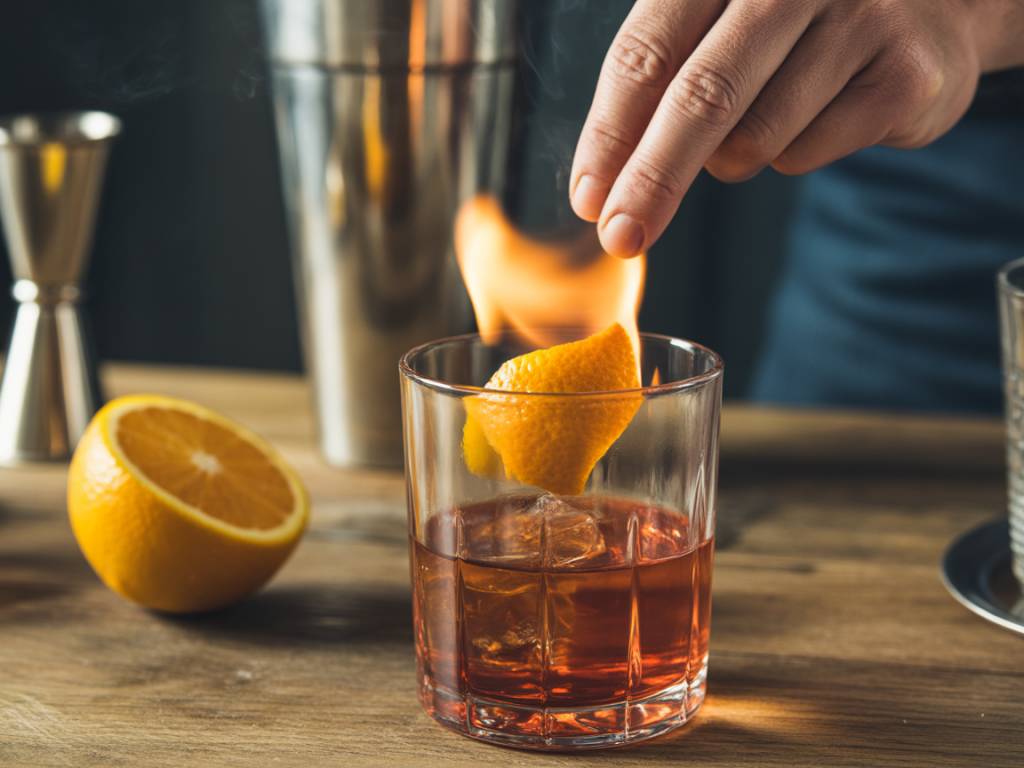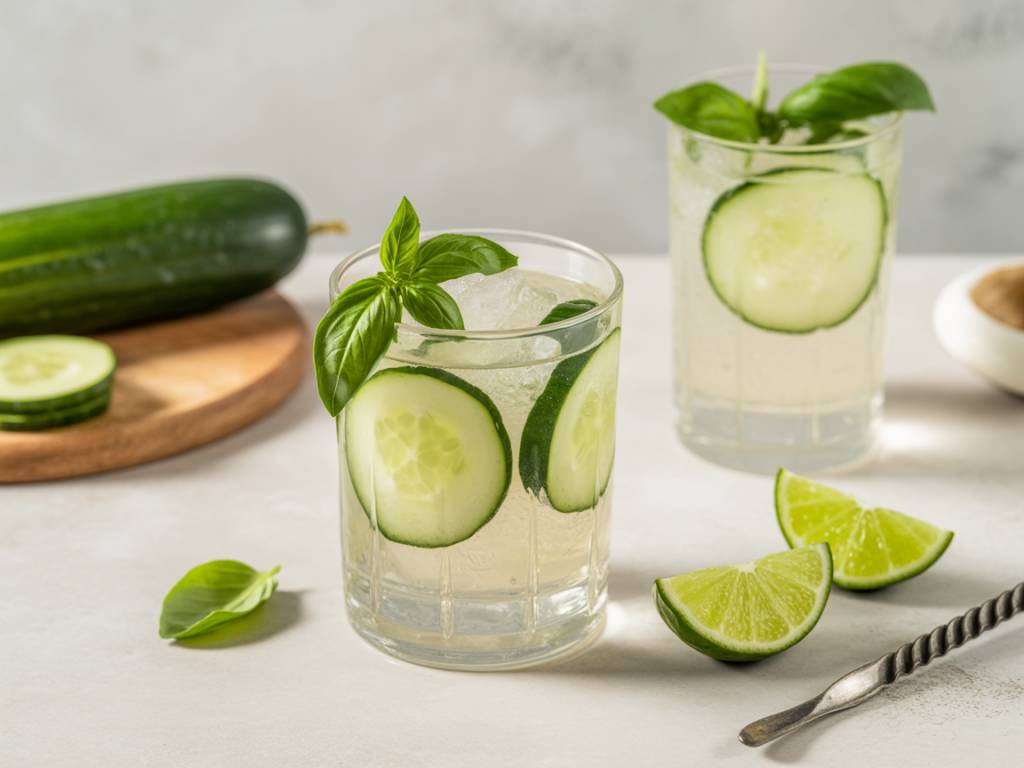Why Flame an Orange Peel in the First Place?
If you’ve ever had a cocktail garnished with a flamed orange peel, you know the moment: the bartender hovers that bright citrus disc near a flame, gives it a gentle squeeze, and for a split second — poof — there’s fire and an aroma burst that hits you right before the drink touches your lips. It’s not just for show (though yeah, it does look cool). Flaming an orange peel adds a layer of complexity that elevates your cocktail from solid to sensational.
The real magic? It comes from the citrus oils. When heated, those oils release volatile compounds that caramelize under the flame. The result: a smoky-citrus aroma that lingers on the surface of your cocktail and subtly infuses the drink with a warm, charred brightness. In other words: depth, aroma, drama — all in one flick of the wrist.
What You’ll Need
Like with any good technique in mixology, the right tools make a difference. Here’s what to grab before you even think about lighting anything on fire:
- Fresh oranges: Look for ones with firm, tight skin. Navel oranges work well, but blood oranges or Cara Caras can add extra flair.
- A sharp vegetable peeler or paring knife: You want a clean strip of peel, no jagged edges.
- A lighter or long match: Butane lighters work best. Avoid kitchen torches — they burn too hot and too fast for this.
- A dry, non-flammable workspace: This could be your cutting board or bar mat. Keep it free of alcohol spills; safety first.
- A cocktail worth the flair: Think Old Fashioneds, Negronis, Boulevardiers — rich, spirit-forward drinks that pair well with a smoky citrus twist.
Step-by-Step: How to Flame an Orange Peel Safely
I’ve taught this technique to plenty of new bartenders, and if there’s one thing I always stress, it’s to respect the flame. Here’s the proper (and safest) way to flame an orange peel like a pro:
Step 1: Cut the Peel
Use your peeler or knife to cut a strip of orange peel roughly 2 to 3 inches long and about an inch wide. You’re aiming for minimal pith — that bitter white layer doesn’t help the flavor and only slows down the ignition of oils.
Step 2: Warm the Peel
Hold the peel between your fingers, peel side down, about 2 to 3 inches above your cocktail glass. Hold a flame between the peel and the drink. You’re not trying to torch it here — just warming the oils so they’re ready to ignite.
Step 3: Flame On
Here’s the move: keeping the flame in place, quickly squeeze the orange peel. You’ll see a small burst of flame as the oils ignite. Boom — that’s the flavor bomb.
Step 4: Rim and Drop (Optional)
Once flamed, you can swipe the peel around the rim of the glass to leave a citrus note for the nose. Then either drop it in the drink as garnish or discard it if you’re going for a cleaner look and just wanted the aroma.
There you go — you’ve just added a layer of artistry and aromatic depth for the price of one orange and a flick of the thumb.
Quick Safety Do’s and Don’ts
- Do make sure your peel is dry. Damp citrus = no flame.
- Do light away from your face or any flammable materials. No leaning in—you want to keep those eyebrows.
- Do keep alcohol away from the lighting area. High-proof spirits catch fire easily. Trust me, I’ve seen more than one bar towel go up in smoke.
- Don’t try to flame over a full bottle of liquor. Common sense — but in the heat of service (pun intended), people forget.
- Don’t use a cigarette lighter that smells of fuel. You want butane for clean burn — otherwise it can taint the aroma.
Best Cocktails to Try It With
Not every drink needs a flamed garnish — but when it fits, you’ll know. These cocktails are practically begging for a little fire:
- Old Fashioned: The ultimate canvas for a flamed orange expression. Smoky citrus complements the richness of bourbon or rye.
- Negroni: The orange oils cut through the bitterness beautifully, adding warmth to the gin-vermouth-Campari trio.
- Espresso Martini (with a twist): Add a hint of orange for a mocha-citrus combo that works surprisingly well.
- Manhattan: Especially good with a twist on the classic recipe — try it with orange bitters and a flamed peel.
- Smoked Boulevardier: This is the cousin of a Negroni made with whiskey. A flamed orange peel takes the smoky, bitter profile over the top.
When to Skip the Flame
Let’s be honest: not every situation calls for a big aromatic presentation. If you’re mixing poolside, serving a round of Margaritas, or shaking drinks for a crowd, it’s fine to ditch the pyrotechnics. Flaming an orange peel is about subtlety and effect — don’t force it into every pour just for show.
I once had a regular order a Daiquiri “with a flamed garnish” because he saw a bartender do it on some Instagram reel. Did I oblige? No way. Lime and smoke don’t dance the same way orange and whiskey do. You’ve got to match technique with context.
Troubleshooting: Why Isn’t My Peel Lighting?
This one comes up a lot behind the bar. Here are the top reasons your peel might be failing to flambé:
- Too much pith: Cut thinner. The oils live in the zest — not the white stuff beneath.
- Overripe fruit: Older oranges dry out. You need fresh, firm fruit for full oil expression.
- Peel is wet: Even a little moisture will block ignition. Pat it dry on a paper towel before lighting.
- Lighter too close or too far: About 2–3 inches away is the sweet spot. You’re warming the peel, not torching it directly.
Bonus: Showmanship Tips from Years Behind the Bar
Over a decade slinging drinks taught me this: half the effect comes from confidence. Even if no guests are watching, treat the flaming peel like it matters — because it does. You’re not just making drinks; you’re creating an experience.
Here are a few performance tips, just in case you like a little flair with your flavor:
- Slow the squeeze: A quick flick is fine, but a slow, deliberate movement makes the flame linger longer — more drama, more aroma.
- Use the glass as a stage: Flame over a coupe or rocks glass with a dark base — it frames the fire beautifully.
- Pre-warm the peel: Rub it between your fingers before lighting. It softens the rind slightly and releases more oil.
And remember: customers might not know what a flamed peel even is. But once they smell it — that smoky-citrus note wrapping around the rim — they’ll know something magical just happened. It’s not just a garnish; it’s the start of the sip.
Needless to say, don’t try this after your fourth tasting round. Save the firework finish for when you’ve got your wits and your technique dialed in. As with any element of mixology, mastery starts with respect — and a good orange.



